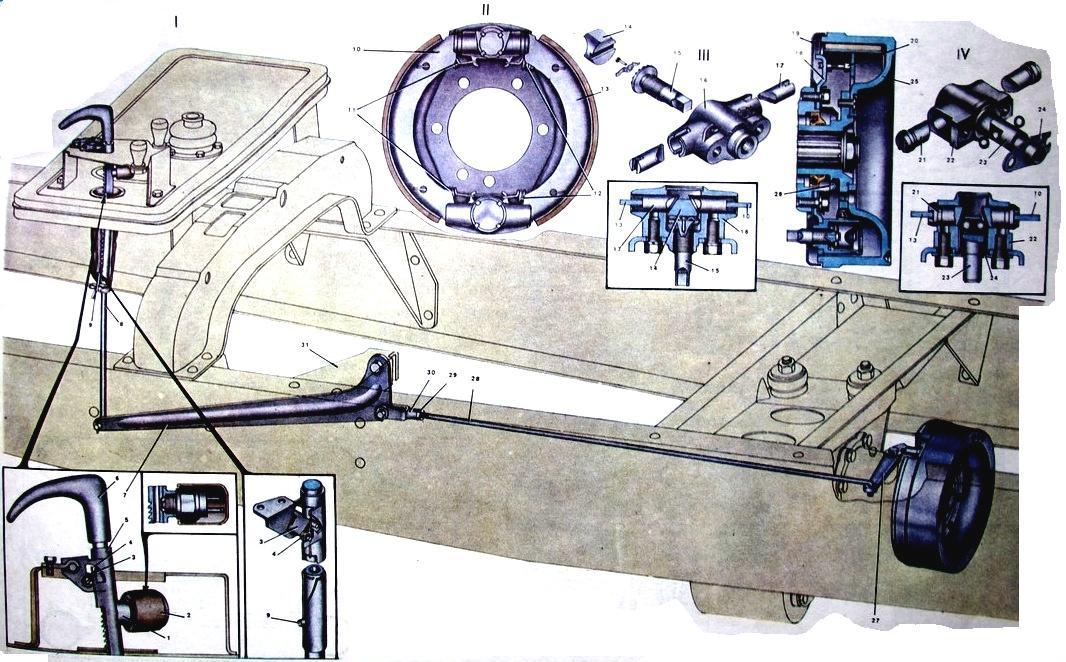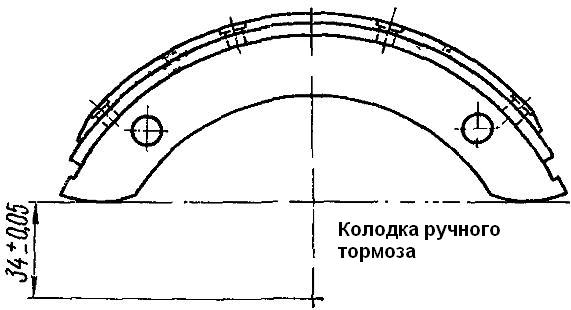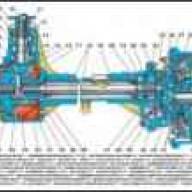The cars are equipped with a drum-type hand brake with a mechanical drive
The brakes are identical in design and differ only in the location of the mounting holes on the shields and drives.
The brake device of the GAZ-66 car and its drive are shown in fig. 1.
Hand brake maintenance
Gap adjustment between pads and brake drum
As the friction linings of the brake pads wear out, the gap between the linings and the brake drum is restored by turning the adjusting screw.
It is recommended to adjust the brakes of the GAZ-53A car in the following sequence.
Hang out the rear wheel (on one side) using a jack.
Place the brake lever in its forwardmost position.
Turn the brake adjusting screw so that the brake drum does not turn by hand.
Loosen the adjusting screw until the drum rotates freely.
If the lever travel is still large after this adjustment, the brake actuator needs to be adjusted. For this you need:
- - tighten the brake adjusting screw so that the brake drum does not turn by hand;
- - adjust the length of the rod with an adjusting fork until the holes in the fork coincide with the hole in the lever, selecting all the gaps in the joints;
- - increase the length of the rod by unscrewing the adjusting fork by 2-3 turns. Tighten the fork locknut, insert the pin (head up) and cotter;
- - loosen the adjusting screw so that the drum rotates freely. When properly adjusted, the lever travel should be 3-5 teeth.
Adjusting the brake of a GAZ-66 car is similar to adjusting the brake of a GAZ-53A car.
When adjusting, place the rear axle and downshift lever in the neutral position. Disengage the front axle and release the pull rod to its lowest position.
When properly adjusted, the drive shaft should extend 10-15 teeth.

Hand Brake Repair
Disassembly and assembly of the handbrake should be done like this.
- 1. Disconnect the front end of the propeller shaft and the drive lever from the linkage.
- 2. Remove drum.
- 3. Loosen the adjusting screw so that the ends of the shoes rest against the body of the adjusting mechanism.
- 4. Remove the springs pressing the ends of the shoes to the adjusting mechanism.
- 5. Remove the ends of the shoes released from the spring from the guide grooves, and then remove the shoes.
- 6. Remove the expansion mechanism and remove the pad pushers, balls and ball housing from it.
- 7. Remove the shoe supports from the adjusting mechanism housing.
The assembly is carried out in the reverse order.
When assembling the pushers, balls, ball housing, pad supports of the adjusting mechanism, pad bearing surfaces, lubricate with a thin layer of grease 1-13 or grease.
Make sure that grease does not get on the lining of the pads.
Inspection and repair
Inspect the working surface of the drum. If there are scuffs, bore the drum. Permissible boring diameter is not more than 221.5 mm.
Inspect the working surface of the friction linings and, if the surface is tarred, clean with sandpaper, if it is oily, rinse with gasoline.
If the rivet depth is less than 0.5 mm, replace the pads.
Replace linings in the same way as wheel brake linings.
The ends of the pads should not have a groove that excludes the possibility of free sliding of the pads in the grooves of the pushers and support pins.
The presence of wear leads to incomplete release of the brake, its heating and premature wear of the brake linings. Therefore, such pads must be replaced with new ones.
Crumpled pad ends can only be cleaned if it is possible to cyanide them to a depth of at least 0.08 mm and harden them.
Riveted pads to the pads are ground so that their radius matches the radius of the bored drum.
Clean up the burrs formed by balls on the bevels of the pushers.
If the balls are corroded or there are dents on the surface, then replace them. Ball diameter 11.9 mm.
|
Rated and repaired dimensions central brake drum |
|
|---|---|
|
Name size |
working diameter surfaces drum, mm |
|
value |
220+0.185 |
|
1st repair |
221+0.185 |
|
2nd repair |
222+0.185 |
|
3rd repair |
223+0.185 |
|
4th repair |
224+0.185 |
The runout of the working surface of the drum relative to the central hole should be no more than 0.3 mm. Sinks on the working surface of the drum are not allowed.
Only new friction linings should be installed on the brake pads, which should fit snugly against the surface of the pad.
The 0.2 mm feeler gauge must not pass more than 15 mm between the lining and the rim of the shoe.
|
Nominal and repair dimensions working surface of pads central brake |
|
|---|---|
|
Name size |
Radius outer surfaces linings, mm |
|
nominal |
110.0+0.05 |
|
1st repair |
110.5+0.05 |
|
2nd repair |
111.0+0.05 |
|
3rd repair |
111.5+0.05 |
|
4th repair |
112.0+0.05 |
Rivet heads should be 2.0 mm below the friction lining.
It is allowed to stick friction linings to the pads with heat-resistant structural adhesives.
Pads with bonded pads must be randomly sheared (see front and rear pad test).
Shoes assembled with pads must have a radius of the working surface corresponding to the size of the brake drum (Table 1).
The runout of the working surface of the pad when installing the complete block according to the dimensions specified in the manufacturer's drawings (Fig. 2) should not exceed 0.20 mm.
The housings of the expanding and adjusting mechanisms of the central brake can have nominal, repair and permissible without repair sizes of holes for pushers and shoe supports.
When assembling the central brake, the parts of the expanding and adjusting mechanism must be lubricated with grease.
After installing the center brake and brake drum, the gearbox must be adjusted. Adjustment is made in the following order:
- - set the central brake lever to the extreme forward position;
- - tighten the adjusting screw so that the brake drum does not turn from the effort of the handle;
- - tighten the spherical nut of the thrust so that the drive lever rests against the body of the balls, then loosen the spherical nut by 2-3 turns and tighten the lock nut;
- - let go adjusting screw so that the drum turns without touching the blocks.
After finishing the adjustment of the central brake, it is necessary to check the splint of the brake lever.









